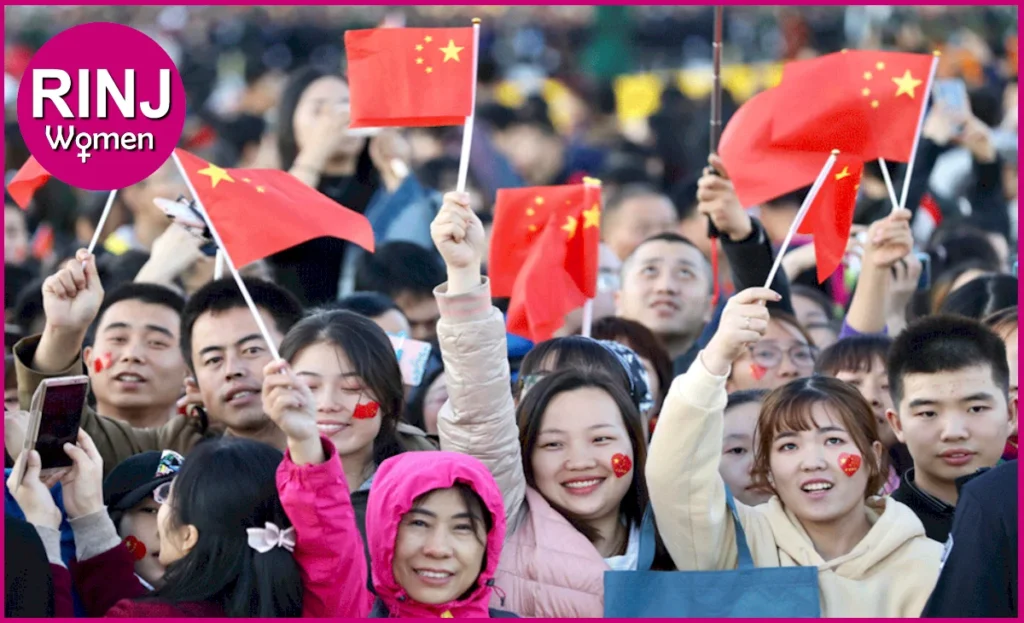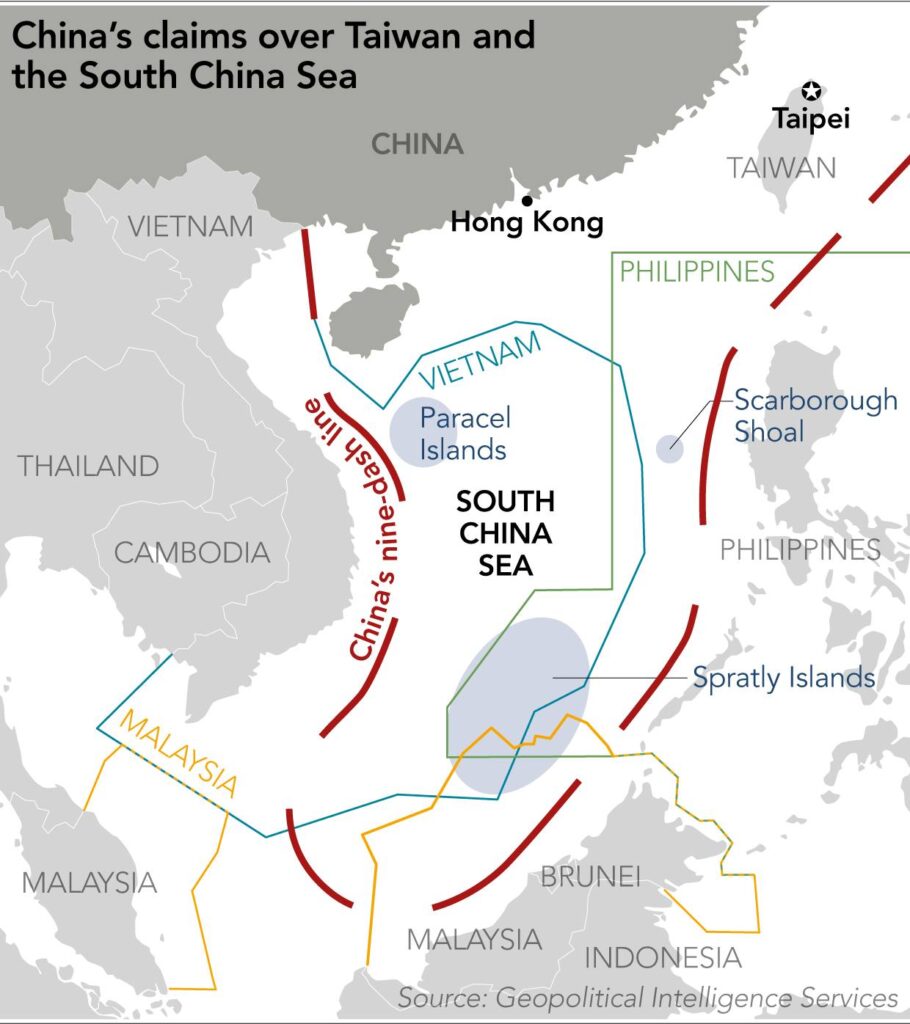China is not your enemy. The Chinese people are not deserving of America’s racial discrimination. China has 1.4 billion mouths to feed and it is doing its best to achieve that goal in concert with the rest of humanity. Do not attack popular culture like the Nine-Dash-Line because it is buried in the Chinese people’s hearts, but instead, listen to the scholars and try a more sophisticated approach. The seas are rising so fast, none of this really matters.
This article by Micheal John, editor of Feminine-Perspective Magazine (FPM) has been written for the DSCS organization and The RINJ Foundation.
The nine-dash line was used by two Chinese governments, the Nationalist Party of Chiang Kai-shek and later by the CCP to illustrate claims to the South China Sea. This has no legal basis, however, according to a July 2016 published decision of the Permanent Court of Arbitration in the Hague.
One of the key issues for some people though, is that the “nature of the claim is ambiguous, and it has never been made explicit by any Chinese government what the nine-dash line represents.” according to the Lowy Institute.
This sets out the nine-dash line as popular culture which while not having a legal basis has an intense foreboding for the current government of China.
Truly, the nine-dash line is buried deep in the hearts of the Chinese people. Xi Jinping cannot do a thing about that.

Joyful ceremony. Flying flags for the Anniversary of the founding of the People’s Republic of China in 1949.
Photo credit: ZHU XINGXIN/CHINA DAILY. Excellent photo is cropped. Art, cropping, enhancement: Rosa Yamamoto / Feminine-Perspective-Magazine
China’s claim to much of the South China Sea is based on a pop-culture obsession with traditional concepts of heritage versus modern common sense in the context of the Earth’s process of change. The little rocks that jutted from the sea over a century ago are gone now. Melting ice and rising seas changed everything.
This is frustrating much of the world and preventing China from doing its utmost best to manage the process of change instead of being dragged along behind change. The seas are rising faster now.
Nothing frustrates people more than the irrationality behind the popular culture Nine Dash Line.
In an article in the June 2013 issue of China National Geography, Shan Zhiqiang, the executive chief editor of the magazine, wrote “The nine-dashed line has been painted in the hearts and minds of the Chinese for a long time.”
Popular culture that is “Painted in the hearts and minds of the Chinese people.”
The people of China would be more than infuriated if any leader were to denounce the so-called “Nine Dash Line” theory of the South China Sea. Xi Jinping has no choice. Popular culture would win the day. He needs to find and use the specific arguments that Chinese scholars are more than able to advance. Xi Jinping will have no more of a chance fighting popular culture among 1.4 billion Chinese people than the rest of the world.
Here we say that particular sea, the SCS, is part of the Asian Seas and don’t use any country’s name in naming seas.
Shan Zhiqiang, editor of China National Geography is correct, and the people of China have a belief that the Nine Dash Line comes from detailed research and study.
It doesn’t.
In 1936, a nationalist geography teacher named Bai Meichu created a map with a solid line encircling all the newly renamed and newly created islands, staking a claim for the motherland. A series of events in WWII changed the status of certain islands but post-war agreements saw all islands come back to China so let’s skip that part of history.
The Eleven Dash Line
By 1946, the Nationalist government of Chiang Kai-shek (31 October 1887 – 5 April 1975), based on Bai Meichu’s work, had published its first official map featuring an eleven-dash line.
The additional two dashes were located in the Gulf of Tonkin, near Northern Vietnam’s coast. That didn’t last.
Communist China later adopted this map; however, Mao Zedong decided to remove the two dashes near North Vietnam as a gesture of goodwill towards a fellow Communist nation in distress.
The dashes adjacent to South Vietnam were retained, with the first dash on contemporary nine-dash maps coinciding with the former boundary between North and South Vietnam.
Despite the animosity between China and Vietnam after 1975, the northern dashes were not reinstated, leading to the current mistaken Nine Dash Line. China can do better than this for its territorial claims.
The same UNCLOS rules that apply to the Philippines and Vietnam as well as a few other contenders for every rock and turf that swell in and out of existence in the Asian Seas, also apply to China.
The Second Thomas shoal is a good example. It is not an island and has no ability to sustain life and thus cannot be claimed by anyone, including China.
China’s man-made islands are a different story. As legal quandaries, there is no answer yet but it is easy to speculate that all of the UNCLOS rules would likely apply.
Despite the ad hoc methodology of the nine-dash line, China’s claims are likely supportable, nevertheless.
China’s claim against the Philippines in several matters puts the Marcos government in the wrong. The Second Thomas Shoal cannot be owned by anyone according to the laws of the sea. (UNCLOS),
For the Philippines people there is zero benefit in pursuing the Second Thomas Shoal ownership claim partly because it sunk with ice-melt and ocean level growth due to massive climate change. Moreover, even for the small few dynasties in Manila seeking to line their pockets with oil and gas riches there is no benefit. They will only become pariahs as fossil fuel burning is looked on in disdain, soon to become a thing of the past.
There is a bigger issue for the millions of families living around the so-called nine dash line: food.
Children in the Philippines are suffering from protein deficient diet and humanitarians from The RINJ Foundation have determined that small fish have disappeared from children’s diets as the quarrels over sovereign rights and the resulting maritime tensions have reduced the catch of small fish to next to nothing.
“The story on how The RINJ Foundation decided to launch global demonstrations against China’s militarization of the South China Sea waterways has its roots in the small coastal villages in Vietnam, Malaysia and the Philippines, and more, where two million or more people and their families depend on living off the sea.
“Those who speak English call them fisher folks. Christ and his apostles were fed from the seas, the Filipino fishing boat captains explain. They cling to the decency and respect their communities have for their work, but their boats are being ransacked by the Chinese Coast Guard, Navy and an even bigger marine militia.
“These humble sea-going fishing crews feed hundreds of millions of Asians at least in small part, with fish. Their once thriving economies filtered through the ranks of commercial partners and customers to stave off poverty for centuries. That is now all gone. China’s massive navy and marine militia of thousands of vessels has raided, robbed, sunk the craft of simple fisher folk and barred their fishing in their own nation’s extended economic zones.
“Mr. Duterte is correct. Getting along with neighbours far outweighs kissing butts in America 11,000 kilometers distant to dodge arrest warrants, Mr. Marcos. Starting a war with China has harmed Philippines fishing catch due to the tensions created and more than half the children under five in the Philippines suffer stunting due to the lack of a fully nutritious diet which is denied because of small fish vanishing from their diet.”
Global Protest against militarization of the South China Sea
FPMag-Explanation-of-the-Tribunal-decision-in-favour-of-the-Philippines

